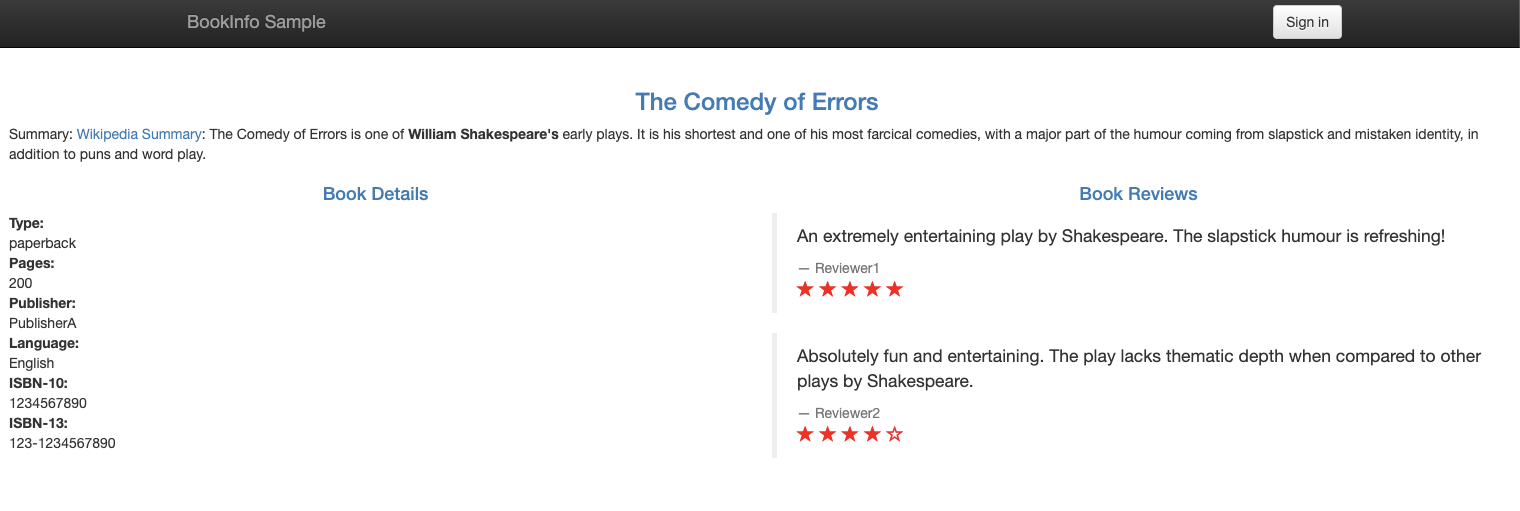Set up routing for sample apps
Set up some Gloo resources to manage multicluster traffic to your Bookinfo and httpbin apps.
The following example creates a route table for your sample apps so that you can route between services across clusters. You can use this setup to test most Gloo policies, such as traffic management, security, and resiliency policies.
Verify in-cluster routing
Verify that the productpage service can route to the reviews-v1 and reviews-v2 services within the same service mesh in cluster1.
In a separate tab in your terminal, open the Bookinfo product page from your local host.
- Enable port-forwarding on the product page deployment.
kubectl --context ${REMOTE_CONTEXT1} -n bookinfo port-forward deployment/productpage-v1 9080:9080 - Open your browser to http://localhost:9080/. You might need to click Normal user to open the app.
- Enable port-forwarding on the product page deployment.
Refresh the page a few times to see the black stars in the Book Reviews column appear and disappear. The presence of black stars represents
reviews-v2and the absence of black stars representsreviews-v1. Note that the styling of red stars fromreviews-v3is not shown because the services incluster1do not currently communicate with the services incluster2.
Figure: Bookinfo product page UI 
Figure: Bookinfo product page UI
Set up multicluster routing
Route between services across the service meshes in your workload clusters. In order for the productpage service on cluster1 to access reviews-v3 on cluster2, you create a virtual destination that represents all versions of the reviews app across both clusters. Then, you create a route table to route from productpage to the virtual destination, and divert 75% of reviews traffic to the reviews-v3 service.
Create a Gloo root trust policy to ensure that services in
cluster1securely communicate with thereviewsservice incluster2. The root trust policy sets up the domain and certificates to establish a shared trust model across multiple clusters in your service mesh.kubectl apply --context $MGMT_CONTEXT -f - <<EOF apiVersion: admin.gloo.solo.io/v2 kind: RootTrustPolicy metadata: name: root-trust namespace: gloo-mesh spec: config: mgmtServerCa: generated: {} EOFRestart istiod and the sample apps that you deployed earlier to apply the updated certificates.
kubectl rollout restart deployment istiod-$REVISION -n istio-system --context $REMOTE_CONTEXT1 kubectl rollout restart deployment istiod-$REVISION -n istio-system --context $REMOTE_CONTEXT2 kubectl rollout restart deployment details-v1 productpage-v1 ratings-v1 reviews-v1 reviews-v2 -n bookinfo --context $REMOTE_CONTEXT1 kubectl rollout restart deployment ratings-v1 reviews-v3 -n bookinfo --context $REMOTE_CONTEXT2 kubectl rollout restart deployment httpbin -n httpbin --context $REMOTE_CONTEXT1 kubectl rollout restart deployment helloworld-v1 helloworld-v2 -n helloworld --context $REMOTE_CONTEXT1 kubectl rollout restart deployment helloworld-v3 helloworld-v4 -n helloworld --context $REMOTE_CONTEXT2Create a virtual destination resource and define a unique hostname that in-mesh gateways can use to send requests to the
reviewsapp. This virtual destination is configured to listen for incoming traffic on the internal-only, arbitrary hostnamereviews.mesh.internal.com:8080. Note that this host value is different than the actual internal address that the reviews app can be reached by, because this host is an internal address that is used only by the gateways in your mesh.kubectl apply --context $MGMT_CONTEXT -n bookinfo -f- <<EOF apiVersion: networking.gloo.solo.io/v2 kind: VirtualDestination metadata: name: reviews-vd namespace: bookinfo spec: hosts: # Arbitrary, internal-only hostname assigned to the endpoint - reviews.mesh.internal.com ports: - number: 9080 protocol: HTTP services: - labels: app: reviews EOFCreate a route table that defines how east-west requests within your mesh are routed from the
productpageservice to thereviews-vdvirtual destination. When you apply this route table, requests fromproductpageto/reviewsnow route to one of the three reviews versions across clusters. The east-west gateway in your mesh does the work of taking requests made to thereviews.bookinfo.svc.cluster.localhostname and routing them to thereviews.mesh.internal.comvirtual destination hostname that you specified in the previous step.kubectl apply --context $MGMT_CONTEXT -n bookinfo -f- <<EOF apiVersion: networking.gloo.solo.io/v2 kind: RouteTable metadata: name: bookinfo-east-west namespace: bookinfo spec: hosts: - 'reviews.bookinfo.svc.cluster.local' workloadSelectors: - selector: labels: app: productpage http: - name: reviews matchers: - uri: prefix: /reviews forwardTo: destinations: - ref: name: reviews-vd kind: VIRTUAL_DESTINATION port: number: 9080 labels: route: reviews EOFIn the
http://localhost:9080/page in your web browser, refresh the page a few times again. Now, the red stars forreviews-v3are shown in the book reviews.
Figure: Bookinfo product page UI with red star reviews 
Figure: Bookinfo product page UI with red star reviews Bookinfo services in
cluster1are now successfully accessing the Bookinfo services incluster2!
Next
Apply a fault injection policy to the reviews service to delay requests and simulate network issues or an overloaded service.